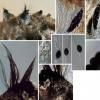
29-03-2025 09:08
 Martine Vandeplanque
Martine Vandeplanque
Bonjour.J’ai essayé d’étudier un Daldinia.Qu

30-03-2025 10:24
Gonzalez Garcia MartaGood morning, I would like to know the opinion of

31-03-2025 17:01
akcay mustafa emreHello everyone, My name is Mustafa Emre Akçay, a

30-03-2025 12:41
Me mandan el material seco de Galicia (España), r

24-03-2025 21:26
Bonjour, J'ai besoin d'une confirmation ou infirm

29-03-2025 06:21
 Francois Guay
Francois Guay
Hi! I found this interesting tiny ascomycete on i

29-03-2025 05:45
Sebastien BassoHello, I'm conducting a mycological inventory in

27-03-2025 22:25
 carl van den broeck
carl van den broeck
On Metzgeria furcata I found hundreds of small whi
 This is yet another Podospora which has developed on a collection of rabbit dung (along with P. (Schizothecium) tetraspora, P. fimiseda and P. pleiospora).
This is yet another Podospora which has developed on a collection of rabbit dung (along with P. (Schizothecium) tetraspora, P. fimiseda and P. pleiospora).It seems to sit uncomfortably between P. setosa and P. curvicolla.
For the former are characters like the shape of the asci (clavate, not saccate), no asci with 256 spores and the gelatinous appendages which are persistent on the mature spores and do not disappear in water mounts.
But the spores seem small for P. setosa and would fit better in P. curvicolla - they measure 16.4-17.3 x 10.4-11.7µm; also in some cases the hairs could be considered 'agglutinated'. I know there are ASCOFrance members with lots of experience of these coprophiles, and would again be grateful for assistance.
Cordialement
Chris

It is sometimes difficult to separate these two species, but the size of the spores and "agglutined" hairs closer to curvicolla.
It is important to measure a large number of spores to have a mean, especially since it is sometimes difficult to count the number of spores within the ascus. I also picked up some copies of P.curvicolla with little hairs "agglutined".
Michel.
